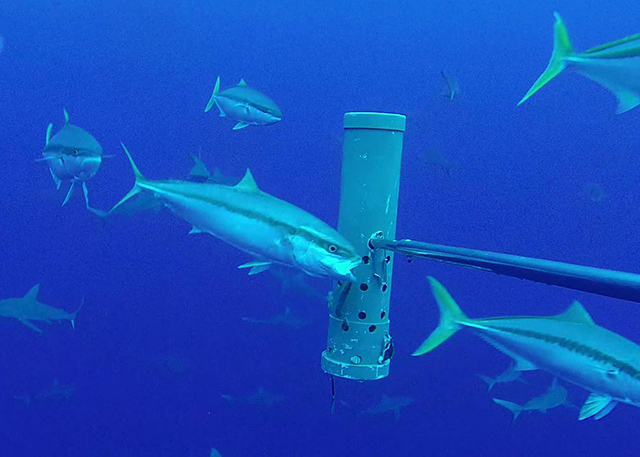Seriola lalandi Valenciennes, 1833
Yellowtail amberjack |
|
Yellowtail kingfish,
Albacore,
Amberjack,
Bandit,
California yellowtail,
Hoodlum,
Kahu,
King amberjack,
Kingfish,
Kingie,
Silver king,
Southern yellowtail,
Tasmanian yellowtail,
Yellowtail,
Yellowtail amberjack,
Yellowtail kingfish
|
| Carangidae (Jacks and pompanos), subfamily: Naucratinae |
| 250 cm TL (male/unsexed); max.weight: 97 kg; max. reported age: 12 years |
|
benthopelagic; brackish; marine; depth range 3 - 825 m |
| Circumglobal in subtropical waters: Series of disjunct populations. Indo-Pacific: South Africa, Walter Shoals, Amsterdam Island, Japan, Australia, New Zealand, New Caledonia, Hawaii, Rapa, Pitcairn Island, and Easter Island. Eastern Pacific: British Columbia, Canada to Chile (Ref. 2850), including Desventuradas Is. and Juan Fernández Is. (Ref. 89357). Eastern Atlantic: St. Helena, South Africa (Ref. 7097). |
|
Dorsal spines (total): 5-6; Dorsal soft rays (total): 33-35; Anal spines: 2-3; Anal soft rays: 20-21. The only jack without scutella on the caudal peduncle. Dark blue dorsally and almost white ventrally; with a well defined line of demarcation between the two colors. |
| Adults are benthopelagic in coastal and oceanic waters, off kelp beds and rocky areas (Ref. 2850), sometimes entering estuaries (Ref. 9563). They are solitary or in small groups and can be found near rocky shores, reefs and islands (Ref. 6390). Schools of juveniles are generally found in offshore waters, often near or beyond the continental shelf (Ref. 27865). They prefer warmer water (18-24°C) although they are occasionally found in cooler water (Ref. 27128). Adults feed on small fish, squid and crustaceans (Ref. 27121). Marketed fresh and salted or dried (Ref. 9283). |
|
Least Concern (LC); Date assessed: 09 March 2015 Ref. (130435)
|
| harmless |
|
Distributed from North Reef in Queensland, around the southern coast to Trigg Island in Western Australia (Ref. 7300). They also occur off the east coast of Tasmania (Ref. 27865) and around Lord Howe and Norfolk islands. Recorded from Shark Bay (Ref. 115274).
Stock structure: A genetic study (Ref. 27865) of yellowtail kingfish stock structure in southern Australian waters revealed significant differences between samples from Greenwell Point in New South Wales. These differences may indicate the existence of distinct subpopulations in New South Wales waters. Tagging data however, point to the presence of a single stock in southeastern Australia (Ref. 27869). Genetic analyses failed to separate yellowtail kingfish samples from Australian, New Zealand or Californian waters (Ref. 27865).
Commercial fishery: The major commercial fishery for yellowtail kingfish in New South Wales, with fishing effort centred around Solitary Island (near Coffs Harbour), Crowdy Head, and around reefs and islands off Sydney, Greenwell Point and Bermagui. In Queensland, yellowtail kingfish are taken as an incidental catch in the snapper (Pagrus auratus) handline fishery. In Western Australia, yellowtail kingfish are caught between Israelite Bay and Shark Bay, although most of the catch is taken between Perth and Geraldton.
The main fishery techniques used in New South Wales are surface and subsurface traps. These account for 80% of the catch. In northern areas, traps are often used as fish aggregating devices (FADs). Other techniques include trolling, bottom set longlines, poling and bottom set traps. Leadlines trolled with live bait are also commonly used at Greenwell Point and Coffs Harbour.
The New South Wales fishery operates all year, but there are large catches of small fish (comprising over 50% of the total annual catch) made between December and February. Poling is carried out at Greenwell Point during October and November, when aggregations of medium size (2-4 kg) fish are targeted. Warehou (Seriolella species) are a bycatch in the trap fishery. Bonito (Sarda species) are sometimes taken by trolling, while a variety of tunas (Scombridae) are caught when poling.
Off southwestern Western Australia, yellowtail kingfish are caught with handlines, droplines, longlines and bottom set gillnets. Gillnet and longline catches are usually considered as bycatch of the Southwest Shark Fishery.
Yellowtail kingfish are marketed as whole, gilled and gutted fish. They are sold on domestic markets in cutlet or fillet form, with better quality fish sold for sashimi (raw fish) and fetching high prices.
Recreational fishery: Yellowtail kingfish are important species for recreational anglers (Ref. 27128, 27869) with most effort concentrated in the summer months. They are usually taken from boats by anglers using handlines and rod-and-line, although they are occasionally taken from the shore. Anglers often fish near traps and other fish aggregating devices.
The Australian Anglers Association records the largest yellowtail kingfish landed as 47.3 kg from New South Wales.
Resource status: The status of yellowtail kingfish resources are unknown. New South Wales commercial catches of yellowtail kingfish have declined in recent years.
Also Ref. 2334, 8879, 9563. |
Source and more info: www.fishbase.org. For personal, classroom, and other internal use only. Not for publication.

